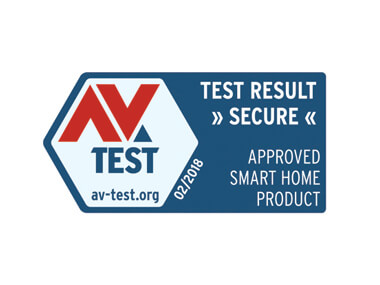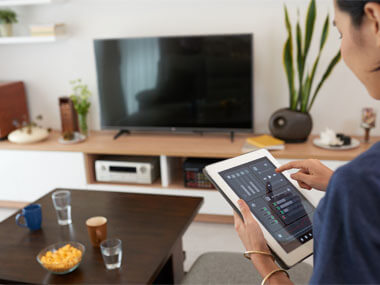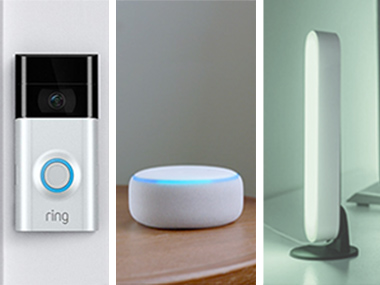
Hypertrend Smart Home: Safety and Comfort for your Daily Live
Get InspiredSmart Home has been a hot topic over the past two years. In its early stages, Smart Homes allowed inhabitants to automatically control the shutters and heating. The various components required elaborate and costly home installations, which made smart solutions a more plausible and interesting concept for new constructions. Nowadays, most producers of Smart Home applications gear their activities towards retrofit solutions. This allows them to address a broader customer base.
What makes a Smart Home smart?
Smart Home is an umbrella term, used to describe the networking and automation of electronic devices within a household. This networking offers greater quality of living and security, higher energy efficiency, and more control of what happens inside (and outside) of one’s own four walls.
Examples of components which can be connected
- Lamps
- Heating control systems
- Speakers
- Sockets
- Fridges
- Stoves
- Coffee machines
- Smoke detectors
- Humidity sensors
- Door locks
What are the benefits of an interconnected home?
The special thing about Smart Homes are their high adaptability and versatility. Everyone can use the (largely retro-fittable) components to design their networked home in a very individualized way, utilizing automation and technical solutions to make their daily lives easier. For those who tend to forget to turn off the lights or heating, a Smart Lock can be connected to the lighting and heating systems. These elements can then be controlled together automatically as soon as you leave the house and lock the door. For those who are always in a hurry in the morning, the coffee maker can be set to turn on automatically as soon as the alarm goes off, and the traffic reports will play on all the speakers of the multi-room sound system. And if the robotic vacuum cleaner always seems to start up whenever your favourite series comes on, you can use the Smart Home solutions to configure the robot to activate when you’re not at home.
But there are even more highly customised Smart Home solutions for specific problems. For example, Airbnb hosts usually find the key transfer to be the most time-consuming process. With a Smart Lock, access permissions can easily be managed from a smartphone, and the door can be opened remotely or using an entry code. Smart Locks also make the daily lives of caretakers much easier, with unscheduled personnel changes no longer posing a problem.
What common Smart Home standards are there?
Bluetooth
The Bluetooth communication standard was developed in the 1990s; since then, each modern smartphone can use Bluetooth making it a widely distributed solutions for peripheral devices, such as headsets and smartwatches. The energy-saving Bluetooth Low Energy technology also facilitates Smart Home solutions. Thanks to the high data rate, Bluetooth communication can be highly encrypted while still offering short reaction times.
Z-Wave
The Z-Wave wireless communication standard was specifically developed for home automation. Z-Wave operates wirelessly and is optimised for low energy consumption. It’s mainly used in automation solutions for private homes and apartments, for wireless control of heating, ventilation, lighting, and alarm and air-conditioning systems.
ZigBee
ZigBee is another very common standard in Smart Homes and it uses a wireless protocol, like Z-Wave. ZigBee is distinguished by its very low energy consumption and is used especially often with smart light bulbs thanks to systems such as Philips Hue, Osram LIGHTIFY, and IKEA Tradfri.
Homematic IP
The Homematic IP communication standard was developed by the German eQ-3 AG company specifically for Smart Home uses. Homematic connects retro-fittable solutions with built-in products. The standard is therefore well-suited for new constructions, controlling blinds and rolling shutters, for example.
Apple HomeKit
Apple developed the HomeKit communication standard, specifically for Smart Home products. HomeKit can transmit data using Wi-Fi as well as Bluetooth. HomeKit products are controlled through the Apple Home app, which is installed as a standard on all iPhones since iOS 10. HomeKit distinguishes itself through its exceptional user-friendliness, allowing even less tech-savvy users to easily access the Smart Home universe.
Amazon Alexa
Amazon managed to capture a considerable market share with its smart loudspeaker “Amazon Echo,” due particularly to its attractively priced entry-level devices and ease of use. In just two years time, Amazon managed to become a big player in the Smart Home market. Alexa primarily uses a Wi-Fi connection to control Smart Home devices through a server connection. With the Amazon Echo Plus, however, Amazon also introduced a Smart Home hub with direct ZigBee connectivity.
Google Assistant
Similar to Amazon Alexa and Apple HomeKit, the Google Assistant isn’t a standalone communication standard, but rather uses a server connection to control its devices. The Google Assistant is installed on all modern Android smartphones and can also be accessed through Android smartwatches. Like Amazon and Apple, Google also distributes connected loudspeakers (Google Home) with a native integration of the Google Voice Assistant, through which Smart Home products can be controlled by voice.
How secure are Smart Home products?
From the very beginning, Smart Home technologies have been the subject of scrutiny from data protection and security experts. Are their concerns justified?
As is so often the case, it all boils down to the actual implementation. Comfort and security aren’t mutually exclusive. With Smart Homes, the communication between the individual devices among themselves and the Internet connection are key. It’s important that the communication is completely encrypted – as is the case with the Nuki electronic door lock –, and that additional security measures prevent external manipulation. Of course, it’s not exactly easy to check how strongly a product is encrypted – but that’s exactly why many manufacturers disclose their encryption system. This demonstrates transparency and makes it possible for outsiders to objectively judge the security concept. This is a common practice in security-related industries and a good indicator of a secure end-product, in line with the principle: “If you’ve got nothing to hide, why fear expert inspections?”
How can you recognise whether a Smart Home product is secure?
Independent tests and certifications are a good initial indication of security. One provider of these types of security tests is the German “AV-Test” institute. AV-Test assesses the security of electronic devices. The institute operates independently from the manufacturer and without prior coordination with the brands. They not only inspect domestic products, but also compare them with their competitors from abroad. Particularly safe products are afterwards awarded the classification of a “safe Smart Home product”. But there are also other experts who carefully inspect the security of Smart Home products. Well-established providers of anti-virus and security solutions, such as Avira, also thoroughly assess the security of products.
Downloads: press images – smart home
Go to the Press Section




